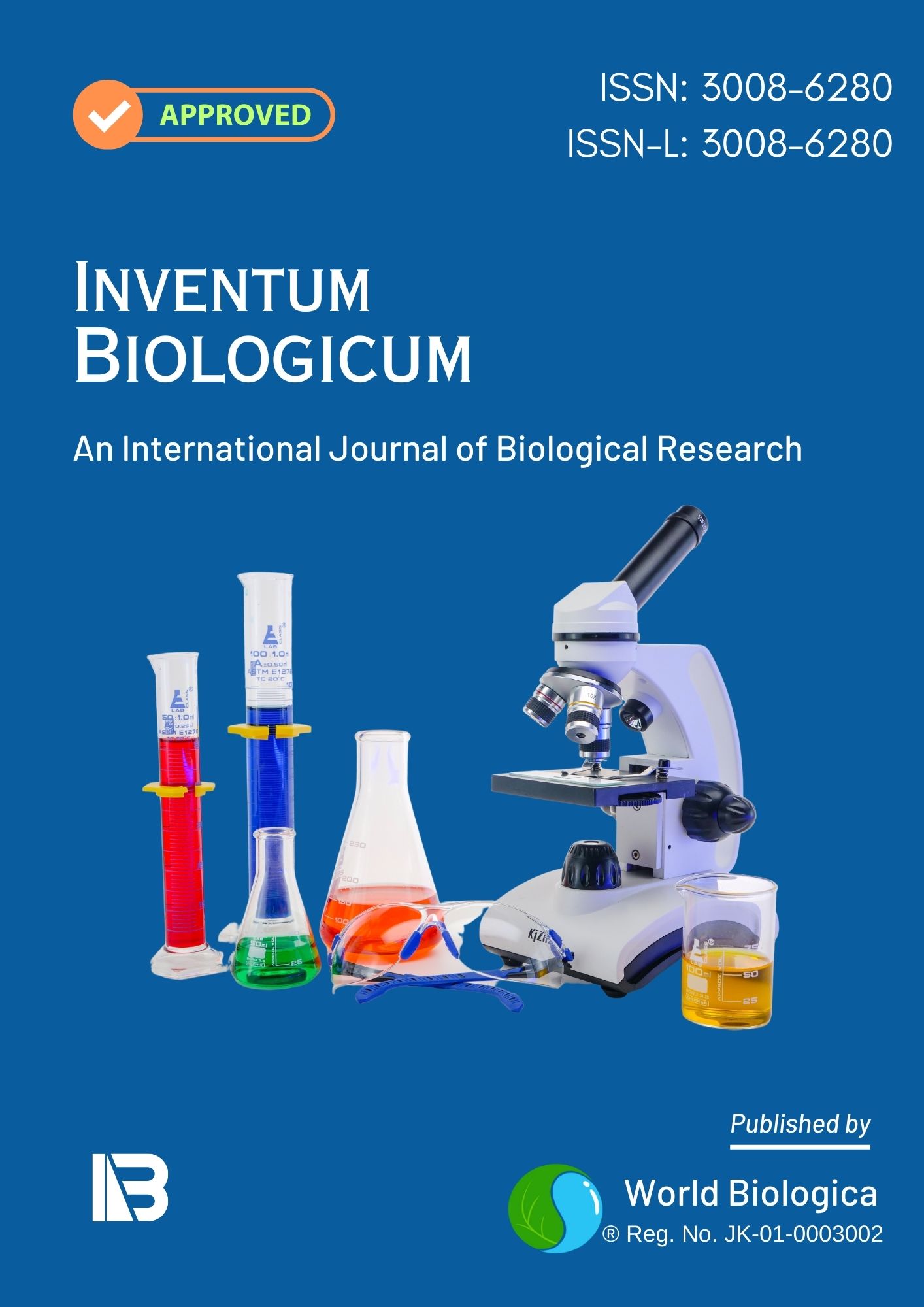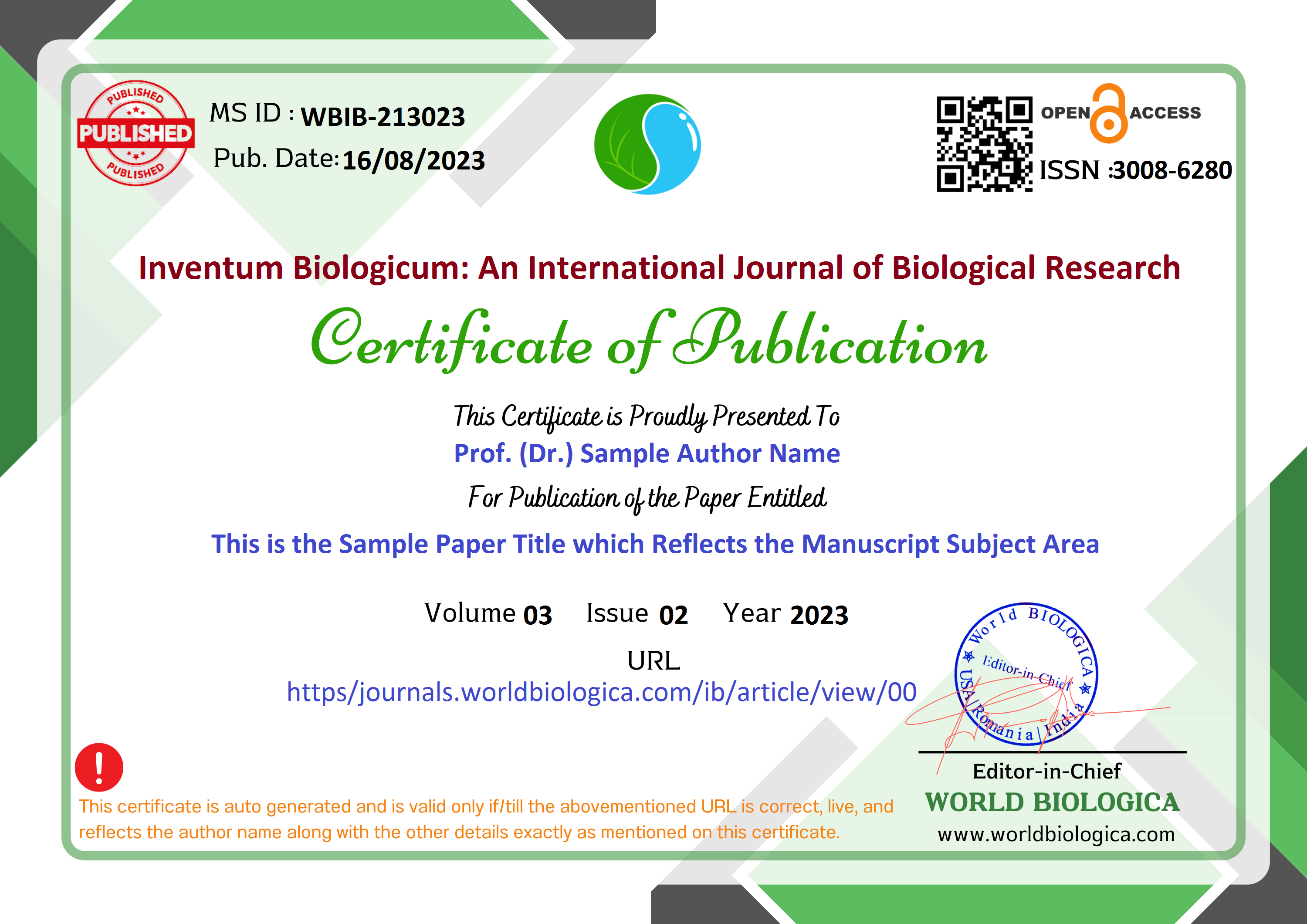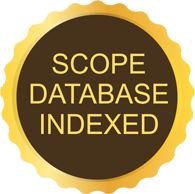Seasonal Dynamics of Phylloplane Mycoflora in Vigna radiata from Arjuni, Mor Taluka, Gondia District, Maharashtra, India
Keywords:
Phylloplane mycoflora, Seasonal dynamics, Fungal diversity, Environmental influence, AgroecosystemsAbstract
The present study investigated the seasonal dynamics of phylloplane mycoflora associated with Vigna radiata (mung bean) cultivated in the Arjuni/Mor Taluka of Gondia District, Maharashtra, India, in 2022. Phylloplane fungal diversity was assessed across three distinct seasons, summer, monsoon, and winter. Thirteen fungal species were identified, with Aspergillus flavus (80%), Aspergillus niger (73.33%), and Penicillium notatum (73.33%) exhibiting the highest overall frequencies. Seasonal variation influenced both the frequency and relative abundance of fungal taxa. The monsoon season had the highest species richness (13 species) and diversity indices (Shannon-Wiener H' = 2.5142, Simpson's D = 0.9147), indicating peak fungal activity, likely due to favorable humidity and temperature conditions. In contrast, the summer exhibited the lowest species richness (10 species). The dominant fungal genera include Aspergillus, Penicillium, Curvularia, and Fusarium, each with varying levels of occurrence across seasons. This study underscores the dynamic nature of phylloplane fungal communities in response to seasonal environmental changes and provides a baseline for future ecological and pathological investigations of mung bean agroecosystems.
Downloads
References
Afolabi, Clement G., Chibundu N. Ezekiel, Abimbola. E. Ogunbiyi, Olufemi J. Oluwadairo, Michael Sulyok, and Rudolf Krska. 2020. “Fungi and Mycotoxins in Cowpea ( Vigna Unguiculata L) on Nigerian Markets.” Food Additives & Contaminants: Part B 13 (1): 52–58. https://doi.org/10.1080/19393210.2019.1690590.
Aliyarukunju, Sabeena, Biju Haridas, and Shiburaj Sugathan. 2023. “Current Insights into Phylloplane Fungal Species Diversity in the Western Ghats and Its Perspective.” In Microbial Biodiversity, Biotechnology and Ecosystem Sustainability, edited by Cristóbal Noé Aguilar, Sabu Abdulhameed, Raul Rodriguez-Herrera, and Shiburaj Sugathan, 295–394. Singapore: Springer Nature Singapore. https://doi.org/10.1007/978-981-19-4336-2_14.
Bolarinwa, K. A., and A. M. Ebabhi. 2018. “Mycological Evaluation of the Phylloplane of Vigna Unguiculata (L.) Walp.” Journal of Applied Sciences and Environmental Management 22 (4): 507–10.
Chanda, Dhritiman, Sashi Prava Devi, and Nibedita Das. n.d. “Ecological Diversity of Phylloplane Mycoflora of Medicinal Plants in Naharlagun, Papumpare District, Arunachal Pradesh, India.” Accessed May 5, 2025. https://www.academia.edu/download/104918299/Paper_6.pdf.
Dai, Yuan-feng, Xiao-mao Wu, Han-cheng Wang, Wen-hong Li, Liu-ti Cai, Ji-xin Li, Feng Wang, Shafaque Sehar, and Imran Haider Shamsi. 2022. “Spatio-Temporal Variation in the Phyllospheric Microbial Biodiversity of Alternaria Alternata-Infected Tobacco Foliage.” Frontiers in Microbiology 13:920109.
Garg, K. Singh, M. Pal, and Keerti Jain. 2019. “Studies on Phylloplane Mycoflora of Some Medicinal Plants.” J. Drug Deliv. Ther 9 (4): 904–7.
Gautam, Ajay K., and Shubhi Avasthi. 2019. Methods in Fungal Biology: A Manual of Laboratory Protocols. Scientific Publishers. https://books.google.com/books?hl=en&lr=&id=7zP3DwAAQBAJ&oi=fnd&pg=PP1&dq=standard+taxonomic+keys+and+manuals+for+identification+of+plant+fungi&ots=k24LBfo-Zt&sig=NvVu7R8xiiZV9DJjCgqlBwW.VxCE
Gomes, Teresa, José Alberto Pereira, Jacinto Benhadi, Teresa Lino-Neto, and Paula Baptista. 2018. “Endophytic and Epiphytic Phyllosphere Fungal Communities Are Shaped by Different Environmental Factors in a Mediterranean Ecosystem.” Microbial Ecology 76 (3): 668–79. https://doi.org/10.1007/s00248-018-1161-9.
Goswami, Susmita, Navodit Goel, and Rita Singh Majumdar. 2021. “Phylloplane Microbes Impact Host Physiology: A Review.” Journal of Plant Protection Research 61 (3). http://psjd.icm.edu.pl/psjd/element/bwmeta1.element.oai-journals-pan-pl-121095/c/oai-journals-pan-pl-121095_full-text_R_01_JPPR_61_3_1026_Goswami.pdf-3.
Gulati, Saloni, P. Chitralekha, Manisha Arora Pandit, Roma Katyal, Neeru Bhandari, Poonam Mehta, Charu Dogra Rawat, Surinder Kaur, and Jasleen Kaur. 2022. “Diversity, Succession and Seasonal Variation of Phylloplane Mycoflora of Leucaena Leucocephala in Relation to Its Leaf Litter Decomposition.” Journal of Fungi 8 (6): 608.
Lokhande, Kailash S., Amit A. Jagiya, and Arun Zingare. 2024. “Dynamics of Phylloplane and Rhizoplane Mycoflora in Sustainable Crop Management of Green Gram and Black Gram.” International Journal of Plant and Environment 10 (03): 174–78.
Longa, Claudia Maria Oliveira, Lidia Nicola, Massimo Pindo, Elisa Bozza, Carmela Sicher, Daniel Bondesan, Ilaria Pertot, and Michele Perazzolli. 2024. “Fungal Biodiversity of Apple Bark, Leaves, Stems, and Fruit Under Rain Shelters with Reduced Fungicide Schedule.” Agriculture 15 (1): 17.
Mir, Mohammad Yaseen, Saima Hamid, and Javid A. Parray. 2022. “Phyllosphere Microbiomes: Implications and Ecofunctional Diversity.” In Microbial Diversity in Hotspots, 81–95. Elsevier. https://www.sciencedirect.com/science/article/pii/B9780323901482000055.
Ogwu, M. C., and M. E. Osawaru. 2014. “Comparative Study of Microflora Population on the Phylloplane of Common Okra [Abelmoschus Esculentus L.(Moench.)].” Nigerian Journal of Biotechnology 28:17–25.
Pandey, R. R., D. K. Arora, and R. C. Dubey. 1993. “Antagonistic Interactions between Fungal Pathogens and Phylloplane Fungi of Guava.” Mycopathologia 124 (1): 31–39. https://doi.org/10.1007/BF01103054.
Pennycook, S. R., and F. J. Newhook. 1981. “Seasonal Changes in the Apple Phylloplane Microflora.” New Zealand Journal of Botany 19 (3): 273–83. https://doi.org/10.1080/0028825X.1981.10426380.
Quintero, Elizabeth, Felix Rivera-Mariani, and Benjamin Bolaños-Rosero. 2010. “Analysis of Environmental Factors and Their Effects on Fungal Spores in the Atmosphere of a Tropical Urban Area (San Juan, Puerto Rico).” Aerobiologia 26 (2): 113–24. https://doi.org/10.1007/s10453-009-9148-0.
Raithak, P. V., and B. D. Gachande. 2011. “Studies on Phyllosphere Mycoflora of Healthy and Virus Infected Tomato Plants.” Asian Journal of Plant Science & Research. https://hal.science/hal-03696466/.
Rinchen, Namgay. 2023. “Study of Diseases Caused by Phylloplane Mycoflora of Selected Orchids in Bhutan.” Sherub Doenme: The Research Journal of Sherubtse College 16.
Ruinen, Jakoba. 1961. “The Phyllosphere: I. An Ecologically Neglected Milieu.” Plant and Soil, 81–109.
Shamsi, Shamim, and Najmun Naher. 2010. “Phylloplane Mycoflora on Vigna Sinensis L.” Dhaka University Journal of Biological Sciences 19 (2): 203–6.
Shara, Melya, Mohammad Basyuni, and Hasanuddin. 2023. “Potential of Phylloplane Fungi from Mangrove Plant (Rhizophora Apiculata Blume) as Biological Control Agents against Fusarium Oxysporum f. Sp. Cubense in Banana Plant (Musa Acuminata L.).” Forests 14 (2): 167.
Tresina, Pious Soris, Edison Dalmeida Daffodil, Packia Lincy, and Veerabahu Ramasamy Mohan. 2014. “Assessment of Biochemical Composition and Nutritional Potential of Three Varieties of Vigna Radiata (L.) Wilezek.” Biolife 2 (2): 655–67.
Tsarelunga, A. A., and E. Yu. Blagoveschenskaya. 2024. “Phylloplane as Fungi Habitat.” Biology Bulletin Reviews 14 (3): 271–85. https://doi.org/10.1134/S2079086424030095.
Uddin, Naim, and Roma Chakraverty. 1996. “Pathogenic and Non-Pathogenic Mycoflora in the Air and Phylloplane ofTriticum Aestivum L.” Aerobiologia 12 (1): 257–68. https://doi.org/10.1007/BF02248162.
Watanabe, Tsuneo. 2018. “Pictorial Atlas of Soilborne Fungal Plant Pathogens and Diseases.” Can J Res 11:18–31.
Zhang, Yulin, Yi Du, Zhihao Zhang, Waqar Islam, and Fanjiang Zeng. 2024. “Unveiling the Diversity, Composition, and Dynamics of Phyllosphere Microbial Communities in Alhagi Sparsifolia across Desert Basins and Seasons in Xinjiang, China.” Frontiers in Microbiology 15:1361756.
Downloads
-
Download PDF
 Abstract Views: 89,
Abstract Views: 89,  Download PDF: 53
Download PDF: 53
Published
How to Cite
Issue
Section
License
Copyright (c) 2025 Inventum Biologicum: An International Journal of Biological Research

This work is licensed under a Creative Commons Attribution-NonCommercial-NoDerivatives 4.0 International License.


















